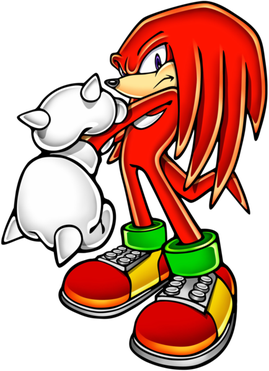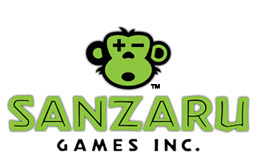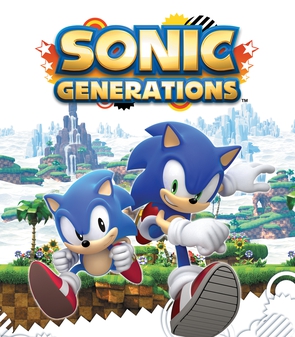
Sonic the Hedgehog is a character created by the Japanese game developers Yuji Naka and Naoto Ohshima. He is the star of the Sonic the Hedgehog franchise and the mascot of the Japanese video game company Sega. Sonic is an anthropomorphic blue hedgehog who can run at supersonic speeds. He races through levels, collecting rings and avoiding obstacles, as he seeks to defeat his archenemy, Doctor Eggman. He is accompanied by supporting characters, such as his sidekick Miles "Tails" Prower, self-proclaimed girlfriend Amy Rose, and friendly rival Knuckles the Echidna.

Knuckles the Echidna is a character from Sega's Sonic the Hedgehog series. He is a red anthropomorphic short-beaked echidna who is Sonic's secondary best friend and former rival. Determined and serious, but sometimes gullible, he fights his enemies using brute force and strength. His role is established as the guardian of the Master Emerald, a large gemstone which controls the series' integral Chaos Emeralds, and is the last living member of his tribe, the Knuckles clan.

Miles Prower, better known by his nickname Tails, is a character from Sega's Sonic the Hedgehog series. Tails also appears in several spin-off games in which he stars, comic books, cartoons, and films. He is the first character to consistently appear by Sonic's side in the series as his best friend, appearing in nearly every mainline and spin-off since his debut. The name "Miles Prower" is a pun on "miles per hour", a reference to the famed speed of Sonic the Hedgehog. Prower is a two-tailed anthropomorphic fox, hence the nickname.

Sonic the Hedgehog is a 1991 platform game developed by Sonic Team and published by Sega for the Genesis/Mega Drive. It was released in North America on June 23 and in PAL regions and Japan the following month. Players control Sonic the Hedgehog, who can run at near supersonic speeds; Sonic sets out on a quest to defeat Dr. Robotnik, a scientist who has imprisoned animals in robots and seeks the powerful Chaos Emeralds. The gameplay involves collecting rings as a form of health, and a simple control scheme, with jumping and attacking controlled by a single button.

Shadow the Hedgehog is a character who appears in Sega's Sonic the Hedgehog franchise. He was created by Takashi Iizuka and Shiro Maekawa and first appeared in Sonic Adventure 2 (2001). Within Sonic's fictional universe, Shadow is an anthropomorphic black hedgehog created by Professor Gerald Robotnik, the grandfather of the series' antagonist Doctor Eggman. After witnessing the death of his best friend Maria Robotnik, Shadow initially seeks revenge, but later vows to keep his promise to her that he would protect the world from danger. An antihero, Shadow has good intentions but will do whatever it takes to accomplish his goals, putting him at odds with Sonic the Hedgehog.

Sonic Adventure 2 is a 2001 platform game developed by Sonic Team USA and published by Sega for the Dreamcast. It features two good-vs-evil stories: Sonic the Hedgehog, Miles "Tails" Prower, and Knuckles the Echidna attempt to save the world, while Shadow the Hedgehog, Doctor Eggman, and Rouge the Bat attempt to conquer it. The stories are divided into three gameplay styles: fast-paced platforming for Sonic and Shadow, multidirectional shooting for Tails and Eggman, and action-adventure exploration for Knuckles and Rouge. Like previous Sonic the Hedgehog games, the player completes levels while collecting rings and defeating enemies. Outside the main gameplay, they can interact with Chao, a virtual pet, and compete in multiplayer battles.

Sonic Advance, known as SonicN on the N-Gage, is a 2001 platform game developed by Dimps and published by Sega for the Game Boy Advance. It was the first Sonic the Hedgehog game released on a Nintendo console with Sonic Adventure 2: Battle on the GameCube, and was produced in commemoration of the series' tenth anniversary. The story follows Sonic, Tails, Knuckles, and Amy as they journey to stop Doctor Eggman from taking over the world. Controlling a character, players are tasked with completing each level, defeating Eggman and his robot army, and collecting the seven Chaos Emeralds.
A sonic boom is a shockwave caused by an aircraft or other object travelling faster than sound.

Sonic the Hedgehog is a video game series and media franchise created by the Japanese developers Yuji Naka, Naoto Ohshima, and Hirokazu Yasuhara for Sega. The franchise follows Sonic, an anthropomorphic blue hedgehog who battles the evil Doctor Eggman, a mad scientist. The main Sonic the Hedgehog games are platformers mostly developed by Sonic Team; other games, developed by various studios, include spin-offs in the racing, fighting, party and sports genres. The franchise also incorporates printed media, animations, feature films, and merchandise.

Sanzaru Games, Inc. is an American video game development company that was founded in Foster City, California in 2006. Sanzaru also has a satellite studio based in Ottawa, Ontario called Kitazaru, as well as an office in Dublin, California. The company name is based on the three wise monkeys.

Sonic Colors is a 2010 platform game published by Sega. It follows Sonic's quest to stop his nemesis Doctor Eggman from enslaving an alien race and taking over the world. The gameplay is similar to prior Sonic games, with players collecting rings and defeating enemies; the camera perspective often switches from third-person to side-scrolling perspectives. The game also introduces Wisps, power-ups the player can use to increase attack power and reach new areas.

Sonic Generations is a 2011 platform game developed by Sonic Team and published by Sega for the PlayStation 3, Xbox 360, Windows, and Nintendo 3DS. Produced in commemoration of the 20th anniversary of the Sonic the Hedgehog series, the game follows Sonic and his sidekick Tails as they form an alliance with their modern selves. It features two gameplay styles: "Classic", which plays from a side-scrolling perspective like that of the original Sega Genesis Sonic games, and "Modern", 3D levels similar to those in Sonic Unleashed (2008) and Sonic Colors (2010).

Sonic Lost World is a 2013 platform game developed by Sonic Team. It is part of the Sonic the Hedgehog series, and was released in October 2013 for the Wii U and Nintendo 3DS in PAL regions by Nintendo and by Sega in North America and Japan. A port of the Wii U version for Windows was later released in November 2015.

Sonic Boom is an animated television series produced by Sega of America, Inc. and Technicolor Animation Productions in collaboration with Lagardère Thématiques and Jeunesse TV, respectively for Cartoon Network, Canal J and Gulli. Loosely based on the video game franchise Sonic the Hedgehog created by Sega, the series is the fifth animated television series based on the franchise and the first to be produced in computer-generated imagery animation and in high-definition.

Sonic Boom: Shattered Crystal is a 2014 action-adventure game developed by Sanzaru Games and published by Sega for the Nintendo 3DS. Along with its Wii U sibling Sonic Boom: Rise of Lyric, Shattered Crystal is a spin-off of Sega's Sonic the Hedgehog franchise and is a part of the Sonic Boom sub-franchise, which consists also of an animated television series, whose games serve as its prequels. The two games together formed the third and final part in Sega's exclusivity agreement with Nintendo, following Sonic Lost World and Mario & Sonic at the Sochi 2014 Olympic Winter Games in 2013.

Sonic Runners was a 2015 endless runner game in the Sonic the Hedgehog franchise for Android and iOS. It was developed by Sonic Team as its first Sonic game exclusive to smartphones and published by Sega. In Sonic Runners, the player-character constantly ran forward, and players controlled their jumping from a side-scrolling perspective using the touchscreen. The game was free-to-play, featured a wide variety of playable characters from the Sonic series, and received periodic updates.

Sonic Boom: Rise of Lyric is a 2014 action-adventure platform video game developed by Big Red Button and published by Sega for the Wii U. Along with Sonic Boom: Shattered Crystal for the Nintendo 3DS, it is a spin-off of Sega's Sonic the Hedgehog series and is a part of the Sonic Boom franchise, which also consists of an animated television series, a comic series by Archie Comics, and a toyline by Tomy. The storyline follows Sonic, Tails, Knuckles and Amy, who must stop Lyric the Last Ancient from acquiring the Chaos Crystals by powering up a robot army and wiping out all organic life, after Sonic accidentally awakens Lyric from a thousand year rest, while escaping Doctor Eggman.

Mario & Sonic at the Rio 2016 Olympic Games is a 2016 crossover sports and party game in the Mario & Sonic at the Olympic Games series, released for the Nintendo 3DS in February 2016 in Japan, March 2016 in North America, and in April 2016 for Europe and Australia, and for the Wii U worldwide in June 2016. The game is officially licensed by the International Olympic Committee, as are the other games in the series. It was developed by Sega, with assistance from Arzest and Spike Chunsoft, and published by Nintendo. It is the fifth title in the Mario & Sonic at the Olympic Games series. The game is a collection of Olympic sports themed mini-games featuring characters from the Mario series and the Sonic the Hedgehog series.


















